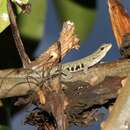en
names in breadcrumbs


Lygodactylus is a genus of diurnal geckos with 82 species. They are commonly referred to as dwarf geckos. They are mainly found in Africa and Madagascar although two species are found in South America. Lygodactylus picturatus, the best known species, is found in Kenya and commonly known as the white-headed dwarf gecko.[3] Recently, illegal importation from Tanzania of brightly colored (and critically-endangered), Lygodactylus williamsi, known as electric blue geckos, has been gaining attention for Lygodactylus geckos in the reptile trade.
Since all trade in wild-caught Lygodactylus williamsi is illegal, shipments of these geckos are often intentionally mislabelled as Lygodactylus spp. or as Lygodactylus capensis.[4] As some customs officials have difficulty identifying members of this genus,[4] a Lygodactylus spp. identification guide has been published online by CITES.[5]
Species in alphabetical order by specific name:[2]

‡ L. blancae (feminine, genitive, singular) is named for (Ms) Françoise Blanc, a French geneticist; but L. blanci (masculine, genitive, singular) is named for (Mr.) Charles Pierre Blanc, a French herpetologist.[7]
Nota bene: A binomial authority in parentheses indicates that the species was original described in a genus other than Lygodactylus.
Lygodactylus is a genus of diurnal geckos with 82 species. They are commonly referred to as dwarf geckos. They are mainly found in Africa and Madagascar although two species are found in South America. Lygodactylus picturatus, the best known species, is found in Kenya and commonly known as the white-headed dwarf gecko. Recently, illegal importation from Tanzania of brightly colored (and critically-endangered), Lygodactylus williamsi, known as electric blue geckos, has been gaining attention for Lygodactylus geckos in the reptile trade.
Since all trade in wild-caught Lygodactylus williamsi is illegal, shipments of these geckos are often intentionally mislabelled as Lygodactylus spp. or as Lygodactylus capensis. As some customs officials have difficulty identifying members of this genus, a Lygodactylus spp. identification guide has been published online by CITES.